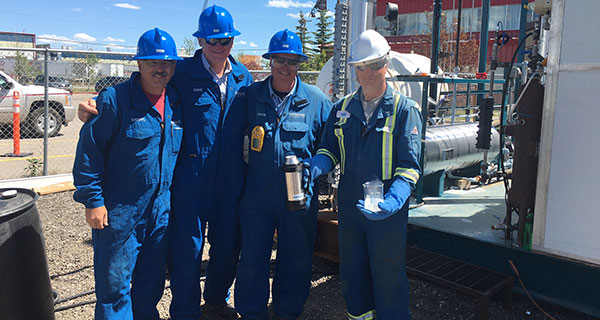 A Calgary-based technology company has developed an innovative, robust and scalable refrigeration/liquefaction technology for the liquefied natural gas (LNG) industry.
A Calgary-based technology company has developed an innovative, robust and scalable refrigeration/liquefaction technology for the liquefied natural gas (LNG) industry.
PTX Technologies Inc. says it’s focused on identifying, evaluating and developing commercial projects that can employ its innovative refrigeration technology to reduce capital, operating costs and improve overall project economics.
Colin Nikiforuk, president and CEO of PTX, said it has designed, constructed and commissioned a 500-usgpd (U.S. gallons per day) LNG pilot/demonstration facility about half an hour southeast of downtown Calgary in Rocky View County. It’s being used to test, validate and demonstrate the technology in action.
The company has a planned 90,000-usgpd Talbot Lake Regional LNG project in Northern Alberta under development, with commercial activity expected by 2020.

Colin Nikiforuk
“The refrigeration technology that has been developed is not just for making LNG. We’re configured here in our pilot plant and the plans at Talbot Lake are to make LNG but the refrigeration technology is also suitable for other gas processing applications. So if you want to do deep cut, or shallow cut. Ethane or propane plus recovery. This is another refrigeration method to achieve that. There’s a multitude of applications for the refrigeration technology,” said Nikiforuk.
Nikiforuk said PTX is holding demonstrations this week at its pilot/demonstration plant. Companies or individuals interested in learning more can connect with him directly at [email protected]
The company says the modified absorption refrigeration process has achieved operating pressures as low as 5 kPa absolute, which results in the ammonia gas chiller operating temperatures as low as -75C.
The applications include:
- LNG production;
- LNG reliquefacton onboard ships or land-based storage;
- gas processing refrigeration for ethane, propane and/or LNG recovery;
- air separation units;
- oil refineries can benefit from additional refrigeration, especially in alkylation units for reaction cooling, LPG recovery units and air-blower-limited FCC units;
- petrochemical complexes where a cold box or process chilling is required;
- mining or other industrial applications requiring cooling/refrigeration.
“We’ve done about as much as we can until we have an off-take secured. There are some mines in the southern Northwest Territories that are quite well advanced and we’re optimistic to secure one of those markets,” said Nikiforuk.
According to the company, since early 2015, Sonoma Resources Ltd., a wholly-owned subsidiary of Cool Ventures Inc., has funded the development of a patent pending that which has broad industrial application where refrigeration is utilized. This new process reduces the scope of overall mechanical rotating equipment required. And when compared to conventional refrigeration systems, it results in significant capital and operating cost savings.
In the fall of 2015, Sonoma decided to further examine whether the new technology could be applied to liquefy natural gas. The LNG configuration of this new process is referred to as the Dense Phase Liquefaction Cycle (DPLC). By the summer of 2016, the DPLC process was successfully tested by commissioning a small-scale pilot facility capable of producing 500 U.S. gallons per day of liquefied natural gas. The test results of the pilot facility were in close agreement with the simulated process design.
In March 2017, PTX Technologies Inc. was incorporated to formally establish a joint ownership position in the new technology with the inventor. The entire rights to the patent pending refrigeration technology and the LNG pilot/demonstration facility are now owned by PTX.
Sonoma has received regulatory approval from the Alberta Energy Regulator to convert its 100 per cent owned Talbot Lake natural gas facility to an LNG supply facility. PTX says the Talbot Lake site is an ideal location to supply LNG to remote mines and communities in Canada’s northern territories.
“We’ve done as much advancement of that project that we can. The Talbot Lake site was a producing natural gas facility. The original gas field that produced for about 25 years has been abandoned. The site is basically decommissioned and ready to become an LNG facility subject to getting an off-take that allows you to get project finance,” said Nikiforuk.
– Mario Toneguzzi for Calgary’s Business
The views, opinions and positions expressed by columnists and contributors are the author’s alone. They do not inherently or expressly reflect the views, opinions and/or positions of our publication.

